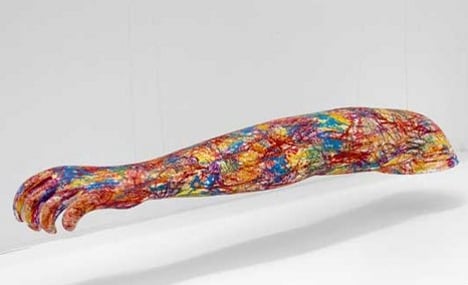For years, low rents and liberal attitudes have lured creative types to Berlin, but their art has been denied the formal exhibition space many feel it deserves.
Berlin Mayor Klaus Wowereit acknowledged as much in his remarks at the official opening of “Based in Berlin” at the city’s Monbijou Atelierhaus last week.
“Many of Berlin’s best artists have exhibition space devoted to them all over the world, but not in Berlin,” he said.
“This exhibition provides an important opportunity for Berlin’s emerging artists to formally showcase their work.”
The project is the latest attempt to raise the profile of Berlin’s vibrant art scene, but the exhibition hasn’t been completely welcomed by it.
Two years ago, a proposal backed by Wowereit to build a new contemporary art museum was scrapped for financial reasons. The current exhibition, which runs just six weeks, has garnered criticism for pouring €1.6 million into a temporary show, no matter how ambitious.
“This initiative ignores the years-long debate surrounding the importance and need for a permanent Berlin art space,” complained hundreds of local artists and curators in an open letter to the mayor earlier this year. “A one-time exhibition spectacle is not a sustainable investment for better production and presentation conditions.”
Be that as it may, five curators selected works from about 80 young painters, sculptors, filmmakers, writers and multimedia performers based in Berlin for the show, which attempts to give Berlin’s diverse and fragmented artist community a collective voice.
An ambitious series of performances, films and concerts will take place at five art institutions in Berlin, including the Neuer Berliner Kunstverein n.b.k. and the Nationalgalerie in the Hamburger Bahnhof, as well as the temporary space created at the Monbijou Atelierhaus, an old art studio set to be demolished in September.
“The show for us was really about creating an overview of the city’s art scene and mapping it,” said Jakob Schillinger, one of the exhibition’s curators.
Limiting the show to 80 artists was a formidable task, given that some 6,000 active artists call Berlin home. From about 1,200 portfolios sent in for the open call, only those on the cutting edge of their respective media were selected.
Another challenge was bringing a motley group of artists, speaking to a dizzying variety of themes, together in one showcase.
“This is not just a repository for art,” Schillinger said of the exhibition. “Our goal is also to expose the process, the production that goes on behind the creation of a typically ‘Berlin’ piece of art.”
Rocco Berger, one artist featured at the exhibition, took that process literally.
His “Oil Painting 2010” features a suspended irrigation hose slowly dripping waste oil onto a plastic sheet hanging below. As oil covers the sheet, it decomposes in a regular wave pattern, revealing the simultaneous creation and destruction of a piece with a finite lifespan.
Japanese-American artist pair Jai Chung and Q Takeki Maeda took a wry, humorous stance on the public support given the project by Wowereit, who is seeking re-election in September.
“The Allegory of Government” consists of an oversized portrait of the mayor adjacent to photos of his most prominent challengers, implying that sometimes, patronizing the arts serves as an effective campaign tool.
The idea of transience recurs in the exhibition — a fitting motif, considering the old Atelierhaus studio is doomed for demolition.
This made for an ironic moment when the curators posed for photos with the mayor, while in the background the heavy stone edifices of Berlin’s leading museums loomed over the river Spree.
“Based in Berlin” runs for less than two months. But if it achieves what it sets out to, the art of the city will outlive any structure eventually built to house it.
‘Based in Berlin’ is free and runs through July 24 at the Monbijoupark Atelierhaus, Oranienburger Straße 77, Berlin-Mitte (along with four additional locations in Berlin).



 Please whitelist us to continue reading.
Please whitelist us to continue reading.
Member comments